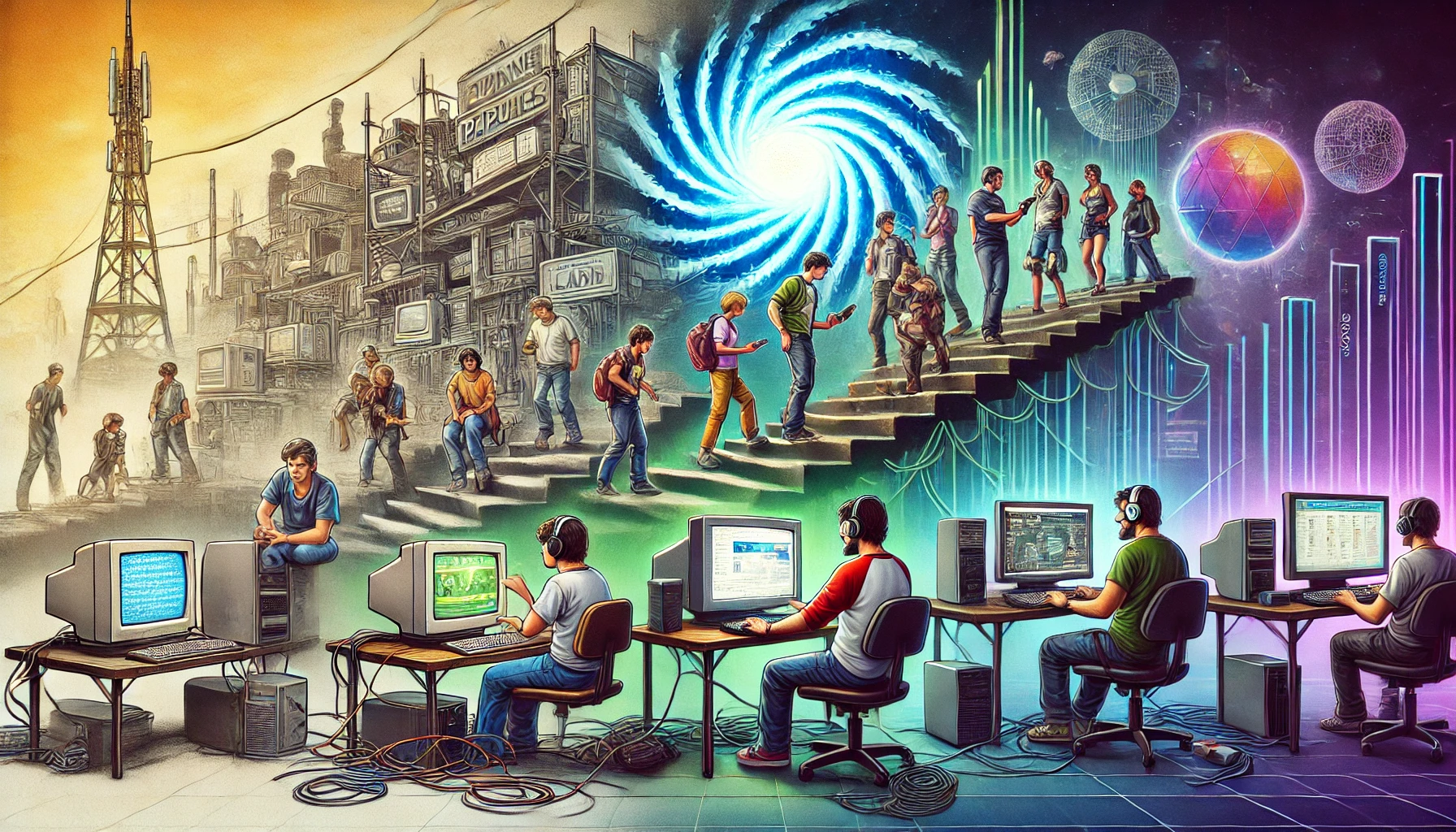Introduction
The landscape of online gaming has undergone a significant transformation, starting as intimate gatherings for game play and evolving into vast, engaging universes in the online realm. This change reflects the swift progress of technological capabilities, wider internet availability, and the enhancement of gaming infrastructures. We will explore the pivotal developments that have shaped online gaming into a worldwide marvel.
Early Stages: The Emergence of LAN Gatherings
The Inception of LAN-Based Play
The concept of online gaming can be traced to the late 20th century with the creation of local area network (LAN) gaming. This form of gaming required linking several computers in close vicinity, typically through Ethernet connections, to facilitate shared gaming sessions. Pioneers of this era would congregate in communal spaces, armed with their personal computers, to join a centralized networking system.
Renowned LAN Games
Noteworthy titles such as “Doom” (1993) and “Quake” (1996), both products of id Software, were among the initial LAN games. These particular titles, which were first-person shooters, introduced the concept of real-time player versus player combat, revolutionizing the multiplayer gaming experience. Consequently, LAN gatherings became an integral part of the gaming community, cultivating camaraderie and competitive spirit.
The Ascension of Internet-Powered Multiplayer Gaming
Transitioning to Online Platforms
With the internet becoming more accessible in the latter part of the 1990s, the gaming sector began gravitating from LAN-based interactions to online multiplayer experiences. The newfound ability to connect with gamers across the globe paved the way for novel opportunities for both developers and players. The advent of broadband internet further smoothed this transition, offering faster and more stable connectivity.
Pioneering Online Multiplayer Titles
Games such as “Diablo” (1996) by Blizzard Entertainment and “Ultima Online” (1997) by Origin Systems stood at the forefront of online multiplayer gaming. “Diablo” was instrumental in popularizing cooperative play via the internet, while “Ultima Online” emerged as one of the initial successful MMORPGs, presenting a perpetual virtual world inhabited by thousands of players concurrently.
The Golden Era of MMORPGs
The Influence of World of Warcraft
Blizzard Entertainment’s “World of Warcraft” (WoW), released in 2004, marked a significant chapter in the history of online gaming. WoW’s captivating universe, extensive backstory, and compelling gameplay drew in a vast player base, cementing its position as a preeminent MMORPG. It set industry benchmarks for the genre, influencing countless subsequent MMO games.
Diversification of MMO Categories
The triumph of WoW catalyzed the creation of a diverse range of MMORPGs spanning various themes. Titles like “EVE Online” (2003) by CCP Games introduced intricate economic systems and the allure of space exploration, whereas “Guild Wars” (2005) by ArenaNet provided a focus on competition and player-versus-player encounters. These games showcased the adaptability and vast potential inherent in the MMO format.
Social Media and Streaming: A New Era of Interaction
Social Media Integration
The emergence of social media in the 2010s significantly altered the online gaming scene. Games began to incorporate features compatible with platforms such as Facebook and Twitter, enabling players to broadcast accomplishments, invite peers to join games, and establish gaming groups. This synergy broadened the audience for online games and attracted a wider player demographic.
The Advent of Game Broadcasting
Platforms dedicated to game streaming, such as Twitch (launched in 2011) and YouTube Gaming (launched in 2015), changed how gamers engaged with games and each other. Streaming permitted players to share their gaming experiences with a worldwide audience, transforming gaming into a spectator event. Esteemed streamers and competitive gaming events drew in vast numbers of viewers, solidifying gaming’s place in mainstream entertainment.
The Modern Era: Expansive Multiplayer Worlds and Future Prospects
The Emergence of New Genres
Recent years have witnessed the rise of new gaming genres like battle royale and multiplayer online battle arena (MOBA) games. Titles such as “Fortnite” (2017) and “PlayerUnknown’s Battlegrounds” (PUBG, 2017) have popularized the battle royale concept, engaging players in survival battles within expansive settings. MOBAs like “League of Legends” (2009) and “Dota 2” (2013) have continued to reign in the competitive gaming sphere.
Online Gaming Horizons: Virtual and Cloud-Based Innovations
As technological advances persist, the future of online gaming promises even greater immersion and availability. Virtual reality (VR) gaming, with apparatuses like the Oculus Rift, ushers players into more tangible virtual experiences. Meanwhile, cloud gaming services such as Google Stadia are democratizing access to high-end gaming experiences, bypassing the need for costly hardware through internet streaming.
Conclusion
The metamorphosis of online gaming from its modest LAN party origins to its current status as a global spectacle underscores the swift progression of technology and the increasing allure of interactive digital entertainment. What began as niche hobbyist meet-ups has burgeoned into a phenomenon captivating millions of players who now connect, compete, and collaborate in vast digital landscapes. Looking ahead, the ongoing infusion of cutting-edge technology is set to further refine the online gaming experience, rendering it more engrossing, reachable, and captivating than ever before.
